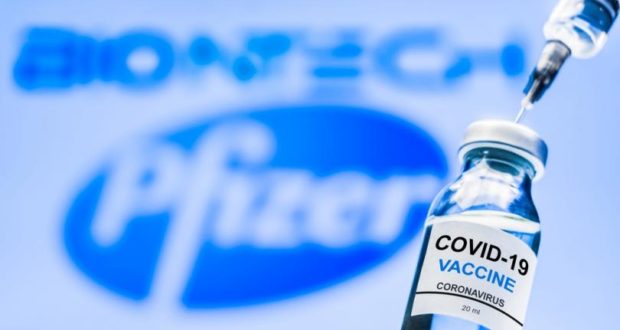الآلاف من الأميركيين يبلغون لـ The Epoch Times عن عدم القدرة على العودة فورًا إلى العمل أو أداء الأنشطة اليومية العادية بعد التطعيم. ❌✋📣
تعرض سبعة عشر شخصًا لرد فعل “يهدد حياتهم” تجاه لقطة COVID-19. كانت ردود أفعال اثنين من السوء لدرجة أدت إلى “إعاقة دائمة”..❌✋📣
منذ الأيام الأولى للحقن الأولى ، بدأ الناس يعانون من أشياء مثل “الغثيان ، والرعشة ، وألم الطعن ، والصفير..❌✋📣
قائمة الأشخاص الذين زاروا غرف الطوارئ بعد تلقي لقاح COVID-19 هي بالمئات وأولئك الذين عانوا من ردود الفعل السلبية يزيد عن 1000 ، وفقًا لنظام الإبلاغ عن الأحداث الضارة للقاح (VAERS).
VAERS هو نظام للإبلاغ تديره مراكز السيطرة على الأمراض والوقاية منها (CDC) وإدارة الأدوية الفيدرالية (FDA). يقوم بجمع معلومات من الجمهور بخصوص ردود الفعل السيئة للقاحات. تجد مراكز السيطرة على الأمراض والوقاية منها وإدارة الغذاء والدواء البيانات مفيدة للكشف عن أي مشاكل محتملة في وقت مبكر مع اللقاحات المرخصة من الولايات المتحدة. وفقًا لموقعه على الويب ، “يُطلب من المتخصصين في الرعاية الصحية الإبلاغ عن بعض الأحداث الضائرة ، ويتعين على مصنعي اللقاحات الإبلاغ عن جميع الأحداث الضارة..”.
منذ الأيام الأولى للحقن الأولى ، بدأ الناس يعانون من أشياء مثل “الغثيان ، والرعشة ، وألم الطعن ، والصفير”.
“أحد العاملين في مجال الرعاية الصحية في مستشفى بارتليت الإقليمي في ألاسكا عانى من رد فعل تحسسي شديد بعد تلقي لقاح فايزر. نقلت إلى غرفة الطوارئ وأمضت عدة ليال هناك قبل أن يتم إخراجها من المستشفى “، حسبما ذكرت صحيفة إيبوك تايمز.
منذ ذلك الحين ، عانى عامل رعاية صحية ثانٍ من نفس المستشفى في ألاسكا من آثار جانبية ضارة من لقاح فايزر-بيو أن تك COVID-19. قام الأطباء بإعطاء الإبينفرين لفتح مجرى الهواء. وجاء في بيان نُشر في موقع مدينة جونو على الإنترنت: “عانى موظف ثانٍ من انتفاخ في العين وخفة في الرأس وخدش في الحلق بعد عشر دقائق من حقنه”.
عانت امرأة أخرى من ألاسكا ، وهي موظفة في Foundation Health Partners في فيربانكس ، من ردّ فعل تحسسي تجاه اللقاح. لم يكن لدى هذه المرأة “أي حساسية معروفة ولكنها عانت في السابق من رد فعل سلبي لدغة النحل. في بيان ، قالت مؤسسة Health Health Partners إن الموظفة كانت تخضع للمراقبة بعد تلقي اللقاح عندما بدأت تعاني من أعراض الحساسية بعد 10 دقائق ، “ذكرت WBTV.
“لقد تلقى النظام تقارير عن إجمالي 1156 أحداث سلبية. من بين هؤلاء ، كان 17 منهم “يهدد الحياة” وأدى اثنان إلى “إعاقة دائمة”.
يقوم الآلاف من الآخرين بالإبلاغ بأنفسهم عن عدم القدرة على العودة فورًا إلى العمل أو أداء الأنشطة اليومية العادية بعد التطعيم. وفقًا لـ The Epoch Times ، تم الإبلاغ عن هذه الحوادث من خلال V-safe ، “تطبيق للهواتف الذكية … يستخدم الرسائل النصية واستطلاعات الويب لتوفير عمليات فحص صحية مخصصة ، ويسمح للمستخدمين بإخبار مركز السيطرة على الأمراض بسرعة إذا كانوا يعانون من آثار جانبية . “
من المفترض أن تقوم إدارة الغذاء والدواء الأمريكية بالتحقيق في ردود الفعل التحسسية تجاه لقاح فيروس كورونا من فايزر.
تقول الإرشادات الحالية لإدارة الغذاء والدواء الأمريكية (FDA) أنه يجب السماح لمعظم الأمريكيين الذين يعانون من الحساسية بأخذ اللقاح ، ولكن يجب ألا يتم تطعيم الأشخاص الذين لديهم ردود فعل شديدة تجاه اللقاحات الأخرى. بالإضافة إلى ذلك ، يجب ألا يحصل الأشخاص الذين ظهرت لديهم ردود فعل تجاه اللقاح على جرعة ثانية.
اعتبارًا من 6 يناير ، بلغ عدد التقارير “308 من المرضى الذين تم إرسالهم إلى غرف الطوارئ بالمستشفى والموثقة على نظام الإبلاغ عن الأحداث الضارة للقاح (VAERS). وهذا يمثل 0.0064 في المائة من إجمالي التطعيمات التي تم إجراؤها ، 4.8 مليون “.
لا يمكن مقاضاة مصنعي اللقاحات إذا كانت منتجاتهم تؤذي أو تقتل شخصًا ما ، وذلك بفضل قانون اتحادي من الثمانينيات ينص على التعامل مع مثل هذه الحالات عبر البرنامج الوطني السري لتعويض إصابات اللقاح. تم انتقاد هذا البرنامج على نطاق واسع من قبل مراقبي سلامة اللقاحات باعتباره غير كاف ومزور ضد المشتكين.
المصدر: lifesitenews.com
Coronavirus vaccines sending hundreds to ER, according to US gov’t reporting system
Seventeen people have had a ‘life threatening’ reaction to the COVID-19 shot. Two reactions were so bad they led to a ‘permanent disability.’
The list of people who have visited emergency rooms after receiving a COVID-19 vaccine is in the hundreds and those who have suffered adverse reactions is over 1,000, according to the Vaccine Adverse Event Reporting System (VAERS).
VAERS is a system of reporting managed by the Centers for Disease Control and Prevention (CDC) and the Federal Drug Administration (FDA). It collects information from the public regarding bad reactions to vaccines. The CDC and FDA find the data useful for detecting any potential problems early on with U.S.-licensed vaccines. According to its website, “Healthcare professionals are required to report certain adverse events and vaccine manufacturers are required to report all adverse events that come to their attention.”
Since the earliest days of the first injections administered, people started experiencing things like “nausea, tremors, stabbing pain, and wheezing.”
“A healthcare worker at Bartlett Regional Hospital in Alaska suffered a suspected severe allergic reaction, or anaphylaxis, after receiving Pfizer’s vaccine. She was taken to the emergency room and spent several nights there before being discharged,” reported The Epoch Times.
Since then, a second health care worker from same hospital in Alaska also suffered adverse side effects from the Pfizer-BioNTech COVID-19 vaccine. Doctors administered epinephrine to open his airways. A statement posted in the city of Juneau’s website reads, “A second staff member experienced eye puffiness, light headedness, and scratchy throat ten minutes after being injected.”
Yet another Alaskan woman, an employee at Foundation Health Partners in Fairbanks, suffered an allergic reaction to the vaccine. This woman did not have “any known allergies but had previously experienced an adverse reaction to a bee sting. In a release, Foundation Health Partners said the employee was being monitored after receiving the vaccine when she began experiencing anaphylactic symptoms 10 minutes later,” reported WBTV.
“The system has received reports of 1,156 total adverse events. Of those, 17 have been ‘life threatening’ and two have led to a ‘permanent disability.’”
Thousands of others are self-reporting an inability to return immediately to work or perform normal daily activities after the vaccine. According to The Epoch Times, these incidents were reported through V-safe, “a smartphone application… that uses text messages and web surveys to provide personalized health check-ins, and allows users to quickly tell the CDC if they’re experiencing side effects.”
The FDA is supposedly investigating allergic reactions to the Pfizer coronavirus vaccine. It has warned the public.
“The FDA’s current guidance says that most Americans with allergies should be cleared to take the vaccine but that people who’ve had severe reactions to other vaccines should not get vaccinated.” Additionally, those who had reactions to the vaccine should not get a second dose.
As of January 6, the number of reports is “308 from patients sent to hospital emergency rooms documented on the Vaccine Adverse Event Reporting System (VAERS). That represents 0.0064 percent of the total vaccinations done, 4.8 million.”
Vaccine manufacturers cannot be sued if their products injure or kill someone, thanks to a federal law from the 1980s that mandates such cases are dealt with via the secretive National Vaccine Injury Compensation Program. That program has been widely panned by vaccine safety watchdogs as inadequate and rigged against complainants.
 Agoraleaks Agoraleaks
Agoraleaks Agoraleaks







